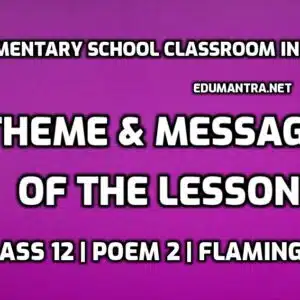
An Elementary School Classroom in A Slum Theme are written by experts. Go through and gain confidence. We at edumantra highly appreciate your feedback regarding An Elementary School in A Slum Theme.
An Elementary School Classroom in A Slum Theme
By- Stephen Spender
The poem touches upon themes of social injustice and class inequality. It questions the value of education in a slum. It exposes the widespread neglect of these children who are uncared for, like rootless weeds. It gives the readers a description of malnourished children with pale faces, stunted growth and twisted bones. But the poem does not dwell upon pessimism. It highlights the role of the educators and the more privileged class in society to liberate the children and infuse them with human creativity.
An Elementary School Classroom in A Slum Theme
An Elementary School Classroom in a Slum deal with the social injustice and class inequalities and attacks on the capitalistic economies in which the rich are becoming richer and even as more and more problems and miseries mire the lives of the poor. They are devoid of any opportunity and have become prey to social injustice. In this poem, Spender demands equal opportunities for education for the poor and the underprivileged.
[pt_view id=”0f31a0c6sa”]
Form
The poem is written in a simple style with the use of poetic devices and images which conveys the narrator’s feelings of sympathy and anger. The images convey the poverty, hunger and neglect of state schools in the slums.
An Elementary School Classroom in A Slum Message
The poem appeals to the rulers, the law enforcing bodies and the philanthropists represented by the ‘governor, inspector, visitor’ to improve the condition of the children in the slums which can be done through education. The poem ends on an optimistic note with the message that there are solutions to this problem and a lot of these children can be improved. The poem raises concerns like sensitivity towards the underprivileged, equity, equality, awareness, philanthropy, optimism, determination, and the need to change the condition of these children
Background of the Poem
Written in 1964, the poem is an example of Spender’s political voice resonating in a poem. He expresses his ideological positions on government, economics, and education. The students in this classroom are underprivileged and malnourished. The capitalistic government is supposed to supply equal opportunity for education, but the classroom in the slum offers little hope for change or progress. Spender names no nation or race. It appears to be a response to the global question concerning social injustice which was an essential issue in the American Civil Rights movement of the time. Throughout the Poem the poet’s tone changes from pensive to belligerent and finally from frustration to an appeal.
[pt_view id=”9a24bf56u9″]